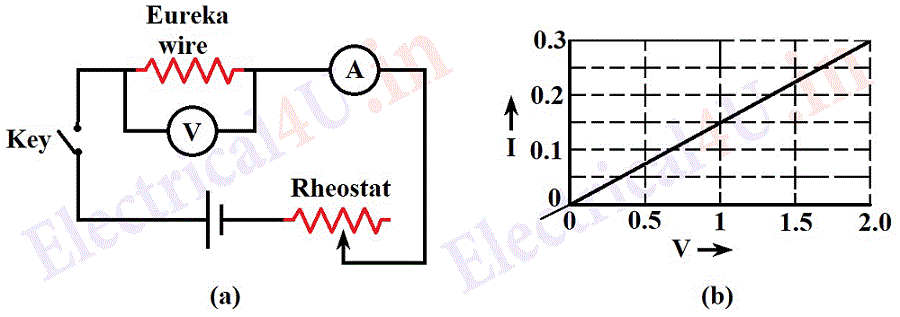Ohm’s Law:- Consider a circuit as shown in Fig. 1 which consists of an ammeter, eureka wire 4 meters length, a rheostat and a battery, all connected in series. A voltmeter has been connected across the two ends of eureka wire. For various settings of the rheostat tabulate the readings of V and I with care that the wire is not heated.
It will be observed that the quotient V/I remains practically constant for all values of V and I, also the graph of I against V is a straight line. The experiment illustrates Ohm’s Law which states that:
If the temperature and other conditions remain constant the current through a conductor is proportional to the applied potential difference and it remains constant.

| PD across the wire V volts | Current through the wire I ampere | V/I |
| 0 | 0 | – |
| 0.67 | 0.1 | 6.7 |
| 0.81 | 0.12 | 6.75 |
| 1 | 0.15 | 6.67 |
| 1.2 | 0.18 | 6.67 |
| 1.34 | 0.2 | 6.7 |
| 1.54 | 0.23 | 6.7 |
| 1.68 | 0.25 | 6.72 |
| 2.01 | 0.3 | 6.7 |
i.e. V/I = Constant = R
Where R has a constant value and is called as the resistance of the conductor.
Alternatively, if the resistance R of the circuit is kept constant the current in the circuit will be directly proportional to the voltage applied across the resistance. If V is measured in volts and the current I is measured in amperes, the ratio of V over I known as resistance is given in ohms. The Ohm’s Law can be expressed in the following three forms:

It should be remember that:-
(1) Ohm’s Law can be applied either to the entire circuit or to a part of circuit. If it is applied to entire circuit the voltage across the entire circuit and the resistance of the entire circuit should be taken into account. If the law is applied to a part of circuit, part resistance and the potential across this part resistance should be used, otherwise a mistake is liable to occur.
(2) The law can well be used for D.C. as well for A.C. circuits, the only difference is that instead of resistance, impedance should be used

Limitations of Ohm’s Law:- The statement of Ohm’s Law holds good under certain simple conditions such as in circuits where the current is due to both conduction and convection currents of electrons and ions respectively, provided the force opposing the motion of each particle is proportional to speed. This force is counter balanced by the forward force acting on them due to applied potential difference. Such conditions are true for metals and electrolytes. However, Ohm’s Law is not applicable under the following conditions:
- For electrolytes where enormous gases are produced on either electrode.
- For metals which are heated by the current to a large extent.
- For vacuum tubes.
- For gas-filled tubes, in which case the ions are generated as the current passes.
- For arc lamps.
- For semi-conductors and appliances such as metal rectifiers and crystal detectors, whose operation depends on the direction of current.
- For silicon carbide, surge suppressors whose operating current I is approximately proportional to V5.
Example:-
A shunt motor has a field resistance of 80 Ohm and is connected across 230 V D.C. mains. If the current through the winding is decreased to 2A, what will be the new supply voltage?

